Articles
- Page Path
- HOME > J Korean Acad Nurs > Volume 41(6); 2011 > Article
-
Original Article
- Effects of Foot Reflexology on Fatigue, Sleep and Pain: A Systematic Review and Meta-analysis
- Jeongsoon Lee, Misook Han, Younghae Chung, Jinsun Kim, Jungsook Choi
-
Journal of Korean Academy of Nursing 2011;41(6):821-833.
DOI: https://doi.org/10.4040/jkan.2011.41.6.821
Published online: December 31, 2011
1Full-time Lecturer, Department of Nursing, Christian College of Nursing, Gwangju, Korea.
2Full-time Lecturer, Department of Nursing, Songwon University, Gwangju, Korea.
3Professor, Department of Nursing, Dongshin University, Naju, Korea.
4Associate Professor, Department of Nursing, Chosun University, Gwangju, Korea.
5Head Nurse, Naju National Hospital, Naju, Korea.
- Address reprint requests to: Han, Misook. Department of Nursing, Songwon University, 365 Songha-dong, Nam-gu, Gwangju 503-742, Korea. Tel: +82-62-360-5945, Fax: +82-62-360-5944, mshan1356@hanmail.net
© 2011 Korean Society of Nursing Science
- 1,721 Views
- 63 Download
- 83 Crossref
Abstract
-
Purpose
- The purpose of this study was to evaluate the effectiveness of foot reflexology on fatigue, sleep and pain.
-
Methods
- A systematic review and meta-analysis were conducted. Electronic database and manual searches were conducted on all published studies reporting the effects of foot reflexology on fatigue, sleep, and pain. Forty four studies were eligible including 15 studies associated with fatigue, 18 with sleep, and 11 with pain. The effects of foot reflexology were analyzed using Comprehensive Meta-Analysis Version 2.0. The homogeneity and the fail-safe N were calculated. Moreover, a funnel plot was used to assess publication bias.
-
Results
- The effects on fatigue, sleep, and pain were not homogeneous and ranged from 0.63 to 5.29, 0.01 to 3.22, and 0.43 to 2.67, respectively. The weighted averages for fatigue, sleep, and pain were 1.43, 1.19, and 1.35, respectively. No publication bias was detected as evaluated by fail-safe N. Foot reflexology had a larger effect on fatigue and sleep and a smaller effect on pain.
-
Conclusion
- This meta-analysis indicates that foot reflexology is a useful nursing intervention to relieve fatigue and to promote sleep. Further studies are needed to evaluate the effects of foot reflexology on outcome variables other than fatigue, sleep and pain.
INTRODUCTION
METHODS
1) Search strategy
2) Selection process of studies
1) Decision of sign for effect size
2) Homogeneity test
3) Effect size
4) Assessment of publication bias
RESULTS
DISCUSSION
CONCLUSIONS
- 1. Cho KS. The effect of hand massage program on anxiety in cataract surgery under local anesthesia. Journal of Korean Academy of Nursing. 1999;29:97–106. doi: 10.4040/jkan.2008.38.2.187.
- 2. Cohen J. Statistical power analysis for the behavioral sciences. 1977;1st ed. New York, Academic Press.
- 3. Choi JS. Effect of foot reflex zone massage on hemodialysis patient stress, depression and fatigue. 2002;Chuncheon, Kangwon National University. Unpublished master's thesis.
- 4. Choi YJ, Jeong HW, Choi SY. A study on the use of alternative medicine for cancer patients admitted at a hospital. Journal of the Korean Public Health Association. 1998;24:167–181.
- 5. Eisenberg D, Kessler RC, Foster G. Unconventional medicine in the United States: Prevalence, costs, and pattern of use. The New England Journal of Medicine. 1993;328:246–252.PubMed
- 6. Evans D. Systematic reviews of nursing research. Intensive Critical Care Nursing. 2001;17:51–57. doi: 10.1054/iccn.2000.1550.ArticlePubMed
- 7. Foltz V, St Pierre Y, Rossignol M, Bourgeois P, Joseois L, Adam V, et al. Use of complementary and alternative therapies by patients with self-reported chronic back pain: A nationwide survey of consumer opinion in Canada. Joint Bone Spine. 2005;72:571–577. doi: 10.1016/j.jbspin.2005.03.018.ArticlePubMed
- 8. Higgins J, Green S. In: Cochrane handbook for systematic review of interventions. 2008;West Sussex, Join Wiley & Sons.
- 9. Im ES, Nam MR. Effect of foot reflexo-massage on the mood, sleep and blood pressure of the women elderly. Journal of Mokpo Science College. 2005;287–316.
- 10. Jeong HK. Heojun's Dong-eui-bogam. 2006;Hadong, Dongeuibogam Company.
- 11. Kim HJ, Lee KS, Lee MH, Jung DS, Yoo JS, Han HS, et al. An analysis of Korea research on complementary and alternative therapy. Journal of Chungju University. 2006;41:529–539.
- 12. Kim KD. Meta-analysis on the foot reflexology intervention program. 2009;Daegu, Keongbuk University. Unpublished doctoral dissertation.
- 13. Kim MY. Meta-analysis of the effectiveness on foot reflexology for cancer patients. 2011;Seoul, Sahmyook University. Unpublished master's thesis.
- 14. Kim SJ. Foot management. 1999;Seoul, Telling of Love Company.
- 15. Kim YS. A theoretical analysis on the foot reflexology emerging as an alternative medicine. New Medical Journal. 2001;44:87–94.
- 16. Lee CY. Room physiotherapy method of treatment to use this school register basic. 1992;Seoul, Iljungsa.
- 17. Lee YC, Park HS. Study on use of alternative therapy in chronic patients. Journal of Korean Academy of Fundamentals of Nursing. 1999;6:96–113.
- 18. Min YC. A meta-analysis of intervention studies on cancer pain. 2011;Seoul, Sahmyook University. Unpublished master's thesis.
- 19. Moher D, Liberati A, Tetzlaff J, Altman DG. PRISMA Group. Preferred reporting items for systematic review and meta-analyses: The PRISMA statement. Annals of Internal Medicine. 2009;151(4):264–269. doi: 10.1371/j.pmed1000097.PubMed
- 20. Nikolaos AP, Evangelos E, John PI. Sensitivity of between-study heterogeneity in meta-analysis: Proposed metrics and empirical evaluation. International Journal of Epidemiology. 2008;37:1148–1157. doi: 10.1093/ije/dyn065.ArticlePubMedPMC
- 21. Norred C, Zamudio S, Palmer SK. Use of complementary and alternatives medicine by surgical patients. The Journal of the American Association of Nurse Anesthetists. 2000;68(1):13–18. doi: 10.1016/S0001-2092(06)61003-X.
- 22. Oh HG. Alternative medicine. 1994;Seoul, Academia.
- 23. Park KP, Kang MG, Kim CB, Kim KS, Jee SH. A meta-analysis on the risk factors of cerebrovascular disorders in Koreans. Journal of Preventive Medicine and Public Health. 1998;31:27–48.
- 24. Park MK. Effects of tai chi on fall risk factors: A meta-analysis. 2011;Daejon, Chungnam National University. Unpublished Doctoral dissertation.
- 25. Scanlin A. Critical appraisal of systemetic reviews of nursing practice. The Australasian Journal of Neuroscience. 2006;18:8–14.
- 26. Shin KR, Kim AJ. Alternative therapy and nursing. 2007;Seoul, Hyunmunsa.
- 27. Sutton AJ, Duval SJ, Tweedie RL, Abrams K, Jones DR. Empirical assessment of effect of publication bias on meta-analysis. British Medical Journal. 2000;320:1574–1577. doi: 10.1136/bmj.320.7249.1574.PubMedPMC
- 28. Song HH. Meta-analysis. 1998;Seoul, Chungmungak.
- 29. The Cochrane collaboration open learning material: Diversity and heterogeneity. The Cochrane Collaboration. 2002;Retrieved May 15, 2011. from http://www.cochrane-net.org/openlearning/HTML/mod13-3.htm.
- 30. Yang JH. The effect of foot reflexology on nausea, vomiting and fatigue of breast cancer patients undergoing chemotherapy. Journal of Korean Academy of Nursing. 2005;35:177–185. doi: 10.4040/jkan.2008.38.2.187.PubMed
REFERENCES
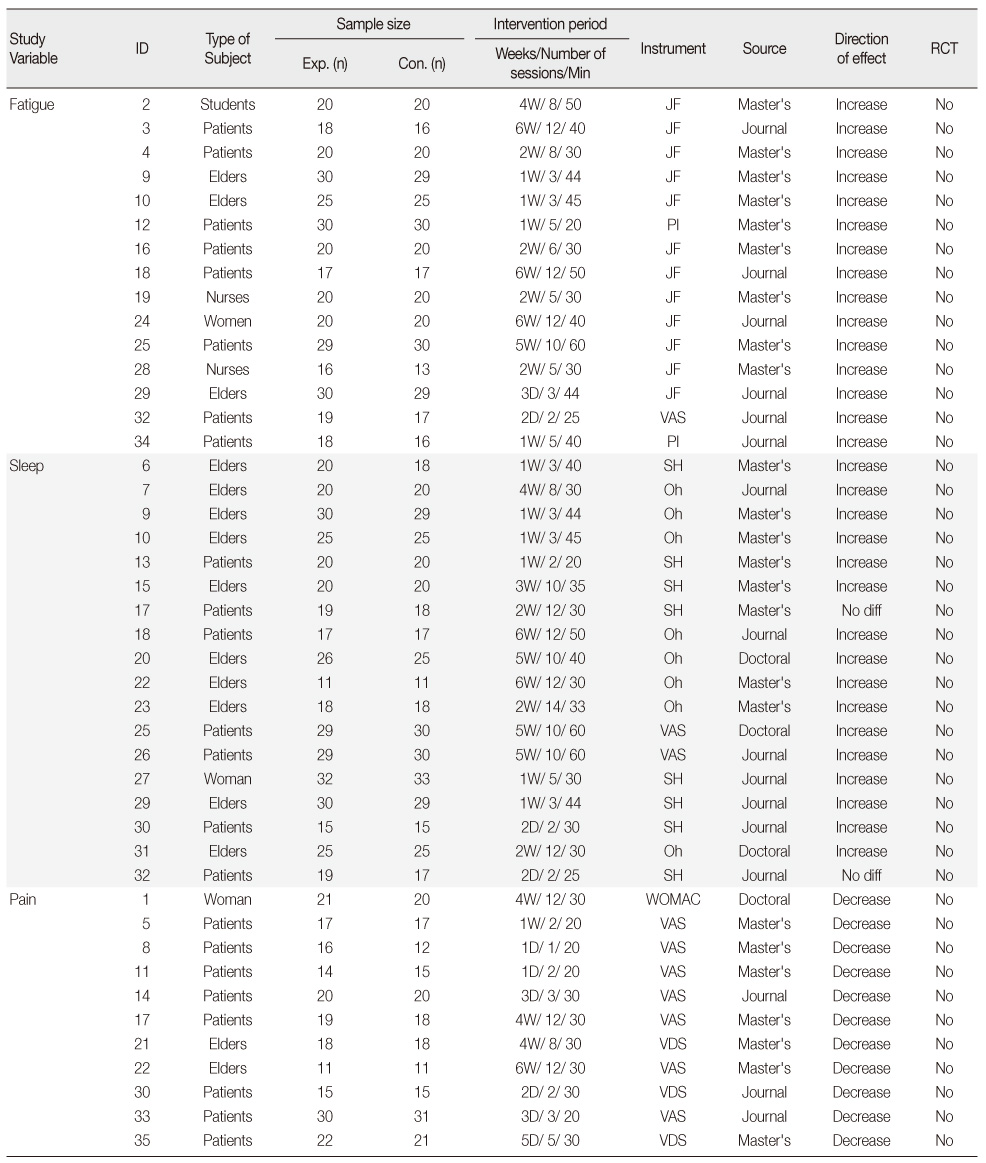
Exp.=Experimental group; Cont.=Control group; W=Weeks; D=Days; Weeks=Duration massages were applied; Min=Time per massage; JF=Japanese labor science institute(subjective symptom) of fatigue; VAS=Visual analogue scale; PI=Piper (1987); SH=Synder-Halpern & Verran (1987); Oh=Oh, Song & Kim (1998); Kim=Kim (1984) ; FAI=Fatigue assessment instrument; VDS=Numerical visual descriptor scale; RCT=Randomised controlled trial; WOMAC=Korean version of Western Ontario MacMaster University Oestoarthritis index questionnaire.
Figure & Data
REFERENCES
Citations

- Combined effects of reflexology massage and respiratory relaxation on pain following chest tube removal in heart surgery patients
Zainab Bahramian, Majid Kazemi, Reza Vazirinejad, Hadi Hasani
Journal of Cardiothoracic Surgery.2025;[Epub] CrossRef - Foot Reflexology for Managing Menopausal Symptoms in Women: A Systematic Review and Meta-Analysis
Mahsa Maghalian, Maryam Alikamali, Farzaneh Aslanpur, Mojgan Mirghafourvand
Current Women s Health Reviews.2025;[Epub] CrossRef - The Effect of Foot Reflexology on Postpartum Comfort and Breastfeeding Outcomes in Postpartum Women: A Meta-Analysis Study
Dilek Menekse, Ahsen Demirhan Kayacik, Kevser Ilcioglu
Breastfeeding Medicine.2025; 20(6): 441. CrossRef - The Effectiveness of Reflexology on Fatigue, Constipation, Nausea and Vomiting During Pregnancy: A Narrative Review
Niloofar Nezhadahmad, Fereshteh Khoshkhoo, Mansour Arad, Zahra Zarei
Journal of Health Reports and Technology.2025;[Epub] CrossRef - A Review of Nursing Thesis on Complementary and Supportive Medicine Practices for Patients with Osteoarthritis: A Systematic Review
Alev Yildirim Keskin, Deniz Zeynep Sönmez
Sakarya Üniversitesi Holistik Sağlık Dergisi.2025; 8(1): 44. CrossRef - Effect of foot reflexology on chronic pain in Parkinson’s disease: A randomized controlled trial
Karel Joineau, Estelle Harroch, Mathilde Boussac, Margherita Fabbri, Clémence Leung, Fabienne Ory-Magne, Vanessa Rousseau, Patrice Peran, Christine Brefel-Courbon, Emeline Descamps, Federico Giove
PLOS One.2025; 20(7): e0327865. CrossRef - The Effect of Foot Reflexology Massage on Fatigue and Sleep Quality in Hemodialysis Patients
Raheleh Rajabi, Fatemeh Akhlaghi, Neda Asadi, Fatemeh Zamani Babgohari, Fatemeh Arabpoor
SAGE Open Nursing.2025;[Epub] CrossRef - Comparing the impact of acupressure and reflexology on fatigue in chronic lymphocytic leukemia patients: A randomized controlled trial with three arms
Naser Parizad, Amireh Hassanpour, Rasoul Goli, Hamidreza Khalkhali, Aysan Nozad
European Journal of Oncology Nursing.2024; 70: 102573. CrossRef - A narrative review of research linking non‐sexual social touch to sleep quality
Yuxi Xie, Brooke C. Feeney
Journal of Sleep Research.2024;[Epub] CrossRef - COMPARISON OF THE EFFECT OF AURICULOTHERAPY AND FOOT REFLEXOLOGY ON THE SENSORY AND EMOTIONAL ASPECTS OF PAIN AND THE USE OF PAINKILLERS AFTER ELECTIVE CAESAREAN SECTION
Fatemeh Sadat Mousavi, Nahid Golmakani, Seyyedeh adeleh Rahmanian
Studies in Medical Sciences.2024; 35(1): 30. CrossRef - Reflexology evidence map
Erika Cardozo Pereira, Caio Fabio Schlechta Portella, Ricardo Ghelman, Carmen Verônica Mendes Abdala, Ana Cláudia Moraes Barros Leite-Mor, Arthur Schveitzer Ferreira, Pamela Gissi Lima, Mariana Cabral Schveitzer
Advances in Integrative Medicine.2024; 11(4): 191. CrossRef - Effect of Reflexology on Pain, Fatigue, Sleep Quality, and Lactation in Postpartum Primiparous Women After Cesarean Delivery: A Randomized Controlled Trial
Ayşegül Kiliçli ID, Simge Zeyneloglu ID
Journal of Human Lactation.2024; 40(2): 221. CrossRef - A Review of the Effect of Foot Reflexology on Pain in Patients
Kinga Vindis, Călin Tudor Hozan, Adrian Coțe, Gheorghe Szilagyi
Archives of Pharmacy Practice.2024; 15(1): 12. CrossRef - The Effect of Foot Reflexology on Fatigue, Sleep Quality, Physiological Indices, and Electrocardiogram Changes in Patients with Acute Myocardial Infarction: A Randomized Clinical Trial
Nilofar Pasyar, Masoume Rambod, Zahra Najafian, Mohammad Hossein Nikoo, Amin Kordi Yoosefinejad, Mahdi Salmanpour
Iranian Journal of Nursing and Midwifery Research.2024; 29(5): 608. CrossRef - Effects of foot reflexology on disease
Ming-Ying He, M Jalal Ud Din, Hai-Feng Xu, Shang-Yu Wang, Guo-Huan Ying, Hao Qian, Bing Wu, Hong-Dan Qi, Xin Wang, Gang Zhang
World Journal of Clinical Cases.2024; 12(35): 6851. CrossRef - Mental Fatigue Classification Aided by Machine Learning-Driven Model Under the Influence of Foot and Auditory Binaural Beats Brain Massages via fNIRS
Nazo Haroon, Hamid Jabbar, Umar Shahbaz Khan, Taikyeong Ted. Jeong, Noman Naseer
IEEE Access.2024; 12: 187160. CrossRef - Comparing the Effects of Hand and Foot Reflexology on Chest Pain in Patients After Primary Percutaneous Coronary Intervention
Nasrin Hanifi, Sahar Asali, Ali Imani
Journal of Archives in Military Medicine.2024;[Epub] CrossRef - The Effect of Reflexology on the Anxiety of Pregnant Women During
Labor: A Systematic Review and Meta-Analysis
Zeinab Abbaszadeh, Jamileh Malakouti, Mahsa Maghalian, Mojgan Mirghafourvand
Current Women s Health Reviews.2023;[Epub] CrossRef - Massage therapy significantly improves cancer-related fatigue in cancer patients: a meta-analysis of randomized controlled trials
Shengnan Shan, Lu Lin, Qian Fang, Fengmei Tian, Daoxia Guo, Yanling Zhou, Li Tian
Supportive Care in Cancer.2023;[Epub] CrossRef - El efecto de la reflexología podal sobre la fatiga en pacientes en hemodiálisis: un estudio de metaanálisis
Seda Şahan, Sevil Güler
Revista Latino-Americana de Enfermagem.2023;[Epub] CrossRef - The effect of foot reflexology on fatigue in hemodialysis patients: a meta-analysis study
Seda Şahan, Sevil Güler
Revista Latino-Americana de Enfermagem.2023;[Epub] CrossRef - Development and Peer Review of an Evidence-Based Decision-Support Tool for Non-Drug Prescribing for Healthy Ageing
Zara Quail, Mark Carter, Charles Young
Journal of Ageing and Longevity.2023; 3(2): 116. CrossRef - Comparing the influence of foot reflexology and fasting mimicking diet on quality of life and sleep quality in obesity hypoventilation syndrome
Rana Hesham Mohamed Elbanna, Sherif Osama Abdelsalam Elabd, Salma Ibrahim Abdelmohsen Alghitany
Journal of Complementary and Integrative Medicine.2023; 20(1): 207. CrossRef - O efeito da reflexologia podal sobre a fadiga em pacientes em hemodiálise: um estudo de metanálise
Seda Şahan, Sevil Güler
Revista Latino-Americana de Enfermagem.2023;[Epub] CrossRef - The Impact of Foot Reflexology on Nausea-Vomiting and Sleep Quality for Lung Cancer Patients Receiving Chemotherapy in Turkey
Hilal Pekmezci, Sevilay Hintistan
Cyprus Journal of Medical Sciences.2022; 7(5): 614. CrossRef - Impact of Nonpharmacologic Interventions Targeting Sleep Disturbances or Disorders in Patients With Inflammatory Arthritis: A Systematic Review and Meta‐Analysis of Randomized Trials
Kristine M. Latocha, Katrine B. Løppenthin, Safa Al‐Bazy, Tannie L. Albrechtsen, Helle E. Jensen, Mikkel Østergaard, Poul J. Jennum, Bente A. Esbensen, Robin Christensen
Arthritis Care & Research.2022; 74(12): 2108. CrossRef - Effect of Complementary and Integrative Treatments on Fatigue Symptoms in Hemodialysis Patients
Melek Yeşil Bayülgen, Meral Gün
Holistic Nursing Practice.2022; 36(1): 17. CrossRef - The impact of foot massage given to postmenopausal women on anxiety, fatigue, and sleep: a randomized-controlled trial
Nilay Gökbulut, Emine Ibici Akça, Çiğdem Karakayali Ay
Menopause.2022; 29(11): 1254. CrossRef - Psychometric properties of the Turkish version of the attitudes toward massage (ATOM) scale
Gizem Göktuna, Gülşah Gürol Arslan, Dilek Özden
European Journal of Integrative Medicine.2022; 55: 102178. CrossRef - The Effects of Foot Reflexology on Vital Signs: A Meta-Analysis of Randomized Controlled Trials
Yunyan Jing, Shanxin Liu, Chunqi Pan, Ying Jian, Mingwei Wang, Bin Ni, Chan-Yen Kuo
Evidence-Based Complementary and Alternative Medicine.2022; 2022: 1. CrossRef - Effects of nonpharmacological intervention on sleep quality in hemodialysis patients
Hui Li, Long Zuo, Siyu Long, Baifei Li
Medicine.2021; 100(27): e26401. CrossRef - The effect of foot reflexology massage on delirium and sleep quality following cardiac surgery: A randomized clinical trial
Ahmad Fazlollah, Hosein Babatabar Darzi, Esmail Heidaranlu, Seyed Tayeb Moradian
Complementary Therapies in Medicine.2021; 60: 102738. CrossRef - Comparing the Effect of Reflexology and Effleurage Massages on Fatigue and Insomnia in Multiple Sclerosis Patients
Sh. Sehat Nejad, A. Pour Samad, M. Behnam Moghadam, A. Mousavi zadeh, N. kaidani
Journal of Clinical Care and Skills.2021; 2(3): 139. CrossRef - Randomized controlled trial of the foot reflexology on pain and anxiety severity during dressing change in burn patients
Fahimeh Davodabady, Vahid Naseri-Salahshour, Mahbobeh Sajadi, Abolfazl Mohtarami, Fatemeh Rafiei
Burns.2021; 47(1): 215. CrossRef - Can foot reflexology be a complementary therapy for sleep disturbances? Evidence appraisal through a meta‐analysis of randomized controlled trials
Hui‐Chuan Huang, Kee‐Hsin Chen, Shu‐Fen Kuo, I‐Hui Chen
Journal of Advanced Nursing.2021; 77(4): 1683. CrossRef - Effect of foot reflexology on chest pain and anxiety in patients with acute myocardial infarction: A double blind randomized clinical trial
Saeedeh Sayari, Monir Nobahar, Raheb Ghorbani
Complementary Therapies in Clinical Practice.2021; 42: 101296. CrossRef - How Long Can they Stand it? Examining the Effectiveness of Reflexology and a Passive Relaxation Intervention in Improving Health Outcomes in Workers Who Stand
Kathryn Kavanagh, Linda Rhoades Shanock
Occupational Health Science.2021; 5(1-2): 95. CrossRef - The effects of reflexology on anxiety, depression and quality of life in patients with gynecological cancers with reference to Watson's theory of human caring
Sinem Göral Türkcü, Sevgi Özkan
Complementary Therapies in Clinical Practice.2021; 44: 101428. CrossRef - The effect of reflexology on sleep quality and fatigue in postmenopausal women: A randomized control trial
Leyla Zengin Aydın, Gülhan Yiğitalp
European Journal of Integrative Medicine.2021; 43: 101281. CrossRef - The Challenges and Perspectives of the Integration Between Virtual and Augmented Reality and Manual Therapies
Francesco Cerritelli, Marco Chiera, Marco Abbro, Valentino Megale, Jorge Esteves, Alberto Gallace, Andrea Manzotti
Frontiers in Neurology.2021;[Epub] CrossRef - Regards sur l’utilisation de la réflexologie palmaire lors d’entretiens cliniques auprès de personnes âgées institutionnalisées : un outil vecteur de bien-être et de qualité de vie ?
C. Moretto, A. Soubelet, C. Bonardi
NPG Neurologie - Psychiatrie - Gériatrie.2021; 21(121): 52. CrossRef - Relaxation interventions for improving sleep outcomes in perinatal women: A systematic review and meta-analysis of randomized controlled trials
Xing Yee Jolyn Tan, Shanise Yi Xin Choong, Ling Jie Cheng, Ying Lau
Midwifery.2021; 103: 103151. CrossRef - Effect of Foot Reflexology and Aromatherapy on Anxiety and Pain During Brachytherapy for Cervical Cancer
Lisa Blackburn, Catherine Hill, Amy Lindsey, Loraine Sinnott, Kathrynn Thompson, Allison Quick
Oncology Nursing Forum.2021; 48(3): 265. CrossRef - Effect of Reflexology in Treating Cancer Pain: A Meta-Analysis
Zhila Najafpour, Kamran Shayanfard
International Journal of Cancer Management.2020;[Epub] CrossRef - Effect of Foot Reflexology Intervention on Depression, Anxiety, and Sleep Quality in Adults: A Meta‐Analysis and Metaregression of Randomized Controlled Trials
Wei-Li Wang, Hao-Yuan Hung, Ying-Ren Chen, Kuang-Huei Chen, Szu-Nian Yang, Chi-Ming Chu, Yuan-Yu Chan, Gerhard Litscher
Evidence-Based Complementary and Alternative Medicine.2020;[Epub] CrossRef - The effect of foot reflexology massage on burn-specific pain anxiety and sleep quality and quantity of patients hospitalized in the burn intensive care unit (ICU)
Reza Alinia-najjar, Masoumeh Bagheri-Nesami, Seyed Afshin Shorofi, Seyed Nouraddin Mousavinasab, Kiarash Saatchi
Burns.2020; 46(8): 1942. CrossRef - Effect of Foot Reflexology on Pain, Fatigue, and Quality of Sleep after Kidney Transplantation Surgery: A Parallel Randomized Controlled Trial
Atena Samarehfekri, Mahlagha Dehghan, Mansoor Arab, Mohammad Reza Ebadzadeh, Albert Moraska
Evidence-Based Complementary and Alternative Medicine.2020;[Epub] CrossRef - Effect of reflexology on anxiety and sleep of informal cancer caregiver: Randomized controlled trial
İsmail Toygar, Öznur Usta Yeşilbalkan, Yasemin Güzel Malseven, Esra Sönmez
Complementary Therapies in Clinical Practice.2020; 39: 101143. CrossRef - Effectiveness of reflexology on anxiety of patients undergoing cardiovascular interventional procedures: A systematic review and meta‐analysis of randomized controlled trials
Ramesh Chandrababu, Eilean Lazarus Rathinasamy, C. Suresh, Jyothi Ramesh
Journal of Advanced Nursing.2019; 75(1): 43. CrossRef - Effects of reflexology on premenstrual syndrome: a systematic review and meta-analysis
Marzieh Hasanpour, Mohammad Mehdi Mohammadi, Habib Shareinia
BioPsychoSocial Medicine.2019;[Epub] CrossRef - La réflexologie plantaire
Emmanuelle Pinon Cartron
Soins Aides-Soignantes.2019; 16(89): 17. CrossRef - Réflexologie dans les troubles du sommeil
Alexandra Lemercier
Hegel.2019; N° 3(3): 246. CrossRef - The effects of sleep hygiene education and reflexology on sleep quality and fatigue in patients receiving chemotherapy
Leyla Zengin, Rukuye Aylaz
European Journal of Cancer Care.2019;[Epub] CrossRef - The effect of foot reflexology massage on breast milk volume of mothers with premature infants: A randomized controlled trial
Parisa Mirzaie, Sakineh Mohammad-Alizadeh-Charandabi, Sakineh Goljarian, Mojgan Mirghafourvand, Mohammad Bager Hoseinie
European Journal of Integrative Medicine.2018; 17: 72. CrossRef - Evaluation des réflexothérapies en 2018
Nathalie Thilly
Hegel.2018; N° 1(1): 76a. CrossRef - The Effectiveness of Foot Reflexology in the Severity of Restless Legs Syndrome in Female Patients Undergoing Dialysis: A Randomized Controlled Trial
Mahbobeh Ghasemi, Nahid Rejeh, Majideh Heravi-Karimooi, Seyed Davood Tadrisi, Parvaneh Samady Kia
Critical Care Nursing.2018;[Epub] CrossRef - Investigating the Impact of Foot Reflexology on Severity of Fatigue in Patients Undergoing Hemodialysis: A Clinical Trial Study
Simin Sharifi, Ali Navidian, Mozhgan Jahantigh, Abouzar Shamsoddini Lori
Medical - Surgical Nursing Journal.2018;[Epub] CrossRef - The effects of reflexology on pain and sleep deprivation in patients with rheumatoid arthritis: A randomized controlled trial
Ercan Bakir, Sevgin Samancioglu Baglama, Savas Gursoy
Complementary Therapies in Clinical Practice.2018; 31: 315. CrossRef - Réflexologie dans les troubles du sommeil
Alexandra Lemercier
Hegel.2018; N° 1(1): 95. CrossRef - The effect of acupressure stimulation of ST-36 – Zusanli, point on lower limbs explosive strength
Dariusz Mucha, Tadeusz Ambroży, Dawid Mucha
European Journal of Integrative Medicine.2017; 11: 59. CrossRef - Effects of foot massage applied in two different methods on symptom control in colorectal cancer patients: Randomised control trial
Neşe Uysal, Sevinç Kutlutürkan, Işıl Uğur
International Journal of Nursing Practice.2017;[Epub] CrossRef - El masaje, una técnica basada en la evidencia
T. Rulleau, C. Rivette, L. Toussaint
EMC - Kinesiterapia - Medicina Física.2017; 38(3): 1. CrossRef - A comparison the effects of reflexology and relaxation on the psychological symptoms in women with multiple sclerosis
Mozhgan Soheili, Fatemeh Nazari, Vahid Shaygannejad, Mahboobeh Valiani
Journal of Education and Health Promotion.2017; 6(1): 11. CrossRef - Reflexology and polysomnography: Changes in cerebral wave activity induced by reflexology promote N1 and N2 sleep stages
N. Esmel-Esmel, E. Tomás-Esmel, M. Tous-Andreu, A. Bové-Ribé, M. Jiménez-Herrera
Complementary Therapies in Clinical Practice.2017; 28: 54. CrossRef - European guideline for the diagnosis and treatment of insomnia
Dieter Riemann, Chiara Baglioni, Claudio Bassetti, Bjørn Bjorvatn, Leja Dolenc Groselj, Jason G. Ellis, Colin A. Espie, Diego Garcia‐Borreguero, Michaela Gjerstad, Marta Gonçalves, Elisabeth Hertenstein, Markus Jansson‐Fröjmark, Poul J. Jennum, Damien Leg
Journal of Sleep Research.2017; 26(6): 675. CrossRef - S3-Leitlinie Nicht erholsamer Schlaf/Schlafstörungen
D. Riemann, E. Baum, S. Cohrs, T. Crönlein, G. Hajak, E. Hertenstein, P. Klose, J. Langhorst, G. Mayer, C. Nissen, T. Pollmächer, S. Rabstein, A. Schlarb, H. Sitter, H.-G. Weeß, T. Wetter, K. Spiegelhalder
Somnologie.2017; 21(1): 2. CrossRef - Il massaggio, approccio basato sulle evidenze
T. Rulleau, C. Rivette, L. Toussaint
EMC - Medicina Riabilitativa.2017; 24(3): 1. CrossRef - Foot Reflexotherapy Induces Analgesia in Elderly Individuals with Low Back Pain: A Randomized, Double‐Blind, Controlled Pilot Study
Bruna Hoffmann de Oliveira, Anna Quialheiro de Abreu da Silva, Daniela Dero Ludtke, Fernanda Madeira, Graciela Mendonça da Silva Medeiros, Rodolfo Borges Parreira, Afonso Shiguemi Inoue Salgado, Luiz Augusto Oliveira Belmonte, Francisco José Cidral-Filho,
Evidence-Based Complementary and Alternative Medicine.2017;[Epub] CrossRef - The effect of foot reflexology and back massage on hemodialysis patients' fatigue and sleep quality
Kevser Sevgi Unal, Reva Balci Akpinar
Complementary Therapies in Clinical Practice.2016; 24: 139. CrossRef - Influence of Study Design on Outcomes Following Reflexology Massage: An Integrative and Critical Review of Interventional Studies
Andrew McVicar, Christina Greenwood, Carol Ellis, Chantelle LeForis
The Journal of Alternative and Complementary Medicine.2016; 22(9): 739. CrossRef - A comparison of the effects of reflexology and relaxation on pain in women with multiple sclerosis
Fatemeh Nazari, Mozhgan Soheili, SayedMohsen Hosseini, Vahid Shaygannejad
Journal of Complementary and Integrative Medicine.2016; 13(1): 65. CrossRef - L’impact de la réflexologie plantaire sur le stress des professionnels de santé
Mireille Guillon, Françoise Bourdarias, Nathalie Lecour
Revue internationale de soins palliatifs.2016; Vol. 30(3): 135. CrossRef - The effects of two methods of reflexology and stretching exercises on the severity of restless leg syndrome among hemodialysis patients
Nahid Shahgholian, ShahrzadKhojandi Jazi, Jahangir Karimian, Mahboubeh Valiani
Iranian Journal of Nursing and Midwifery Research.2016; 21(3): 219. CrossRef - Complementary and Alternative Medicine Therapies as Symptom Management Strategies for the Late Effects of Breast Cancer Treatment
Ashley M. Henneghan, Tracie Harrison
Journal of Holistic Nursing.2015; 33(1): 84. CrossRef - Topography of spinal column and kidney receptors as illustrated by microsystem of the foot
Tadeusz Kasperczyk, Robert Walaszek
Journal of Traditional Chinese Medicine.2015; 35(3): 329. CrossRef - Self-Administered Foot Reflexology for the Management of Chronic Health Conditions: A Systematic Review
Hyun Jin Song, Sun Mi Choi, Hyun-Ju Seo, Heeyoung Lee, Heejeong Son, Sanghun Lee
The Journal of Alternative and Complementary Medicine.2015; 21(2): 69. CrossRef - Effect of self-administered foot reflexology for symptom management in healthy persons: A systematic review and meta-analysis
Hyun Jin Song, Heejeong Son, Hyun-Ju Seo, Heeyoung Lee, Sun Mi Choi, Sanghun Lee
Complementary Therapies in Medicine.2015; 23(1): 79. CrossRef - The effect of foot reflexology on physiologic parameters and mechanical ventilation weaning time in patients undergoing open-heart surgery: A clinical trial study
Abbas Ebadi, Parastoo Kavei, Seyyed Tayyeb Moradian, Yaser Saeid
Complementary Therapies in Clinical Practice.2015; 21(3): 188. CrossRef - Healing Art of Hand: Reflexology
H. Dilek Doğan
European Journal of Basic Medical Sciences.2014; 4(4): 89. CrossRef - The Physiological and Biochemical Outcomes Associated with a Reflexology Treatment: A Systematic Review
J. E. M. McCullough, S. D. Liddle, M. Sinclair, C. Close, C. M. Hughes, Peter Mackereth
Evidence-Based Complementary and Alternative Medicine.2014;[Epub] CrossRef - Meta-Analysis of Spiritual Intervention Studies on Biological, Psychological, and Spiritual Outcomes
Pok-Ja Oh, Young-Hyun Kim
Journal of Korean Academy of Nursing.2012; 42(6): 833. CrossRef - RECENT LITERATURE
Focus on Alternative and Complementary Therapies.2012;[Epub] CrossRef - RECENT LITERATURE
Focus on Alternative and Complementary Therapies.2012;[Epub] CrossRef
- Figure
- We recommend
- Related articles
-
- Effectiveness of non-pharmacological interventions to reduce internalized stigma in people with severe mental illness: a systematic review and meta-analysis
- Effect of Digital Health Interventions on Psychotic Symptoms among Persons with Severe Mental Illness in Community: A Systematic Review and Meta-Analysis
- Effects of Health Education Using Virtual Reality for Adolescents: A Systematic Review and MetaAnalysis
- Factors Related to Emotional Leadership in Nurses Manager: Systematic Review and Meta-Analysis
- Effects of Non-Pharmacological Interventions on Major Adverse Cardiac Events in Patients Underwent Percutaneous Coronary Intervention: Systematic Review and Meta-Analysis
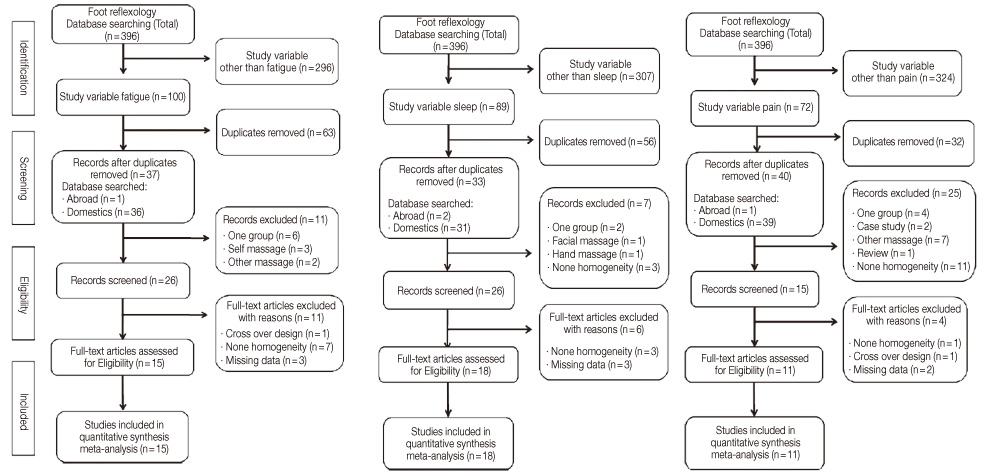
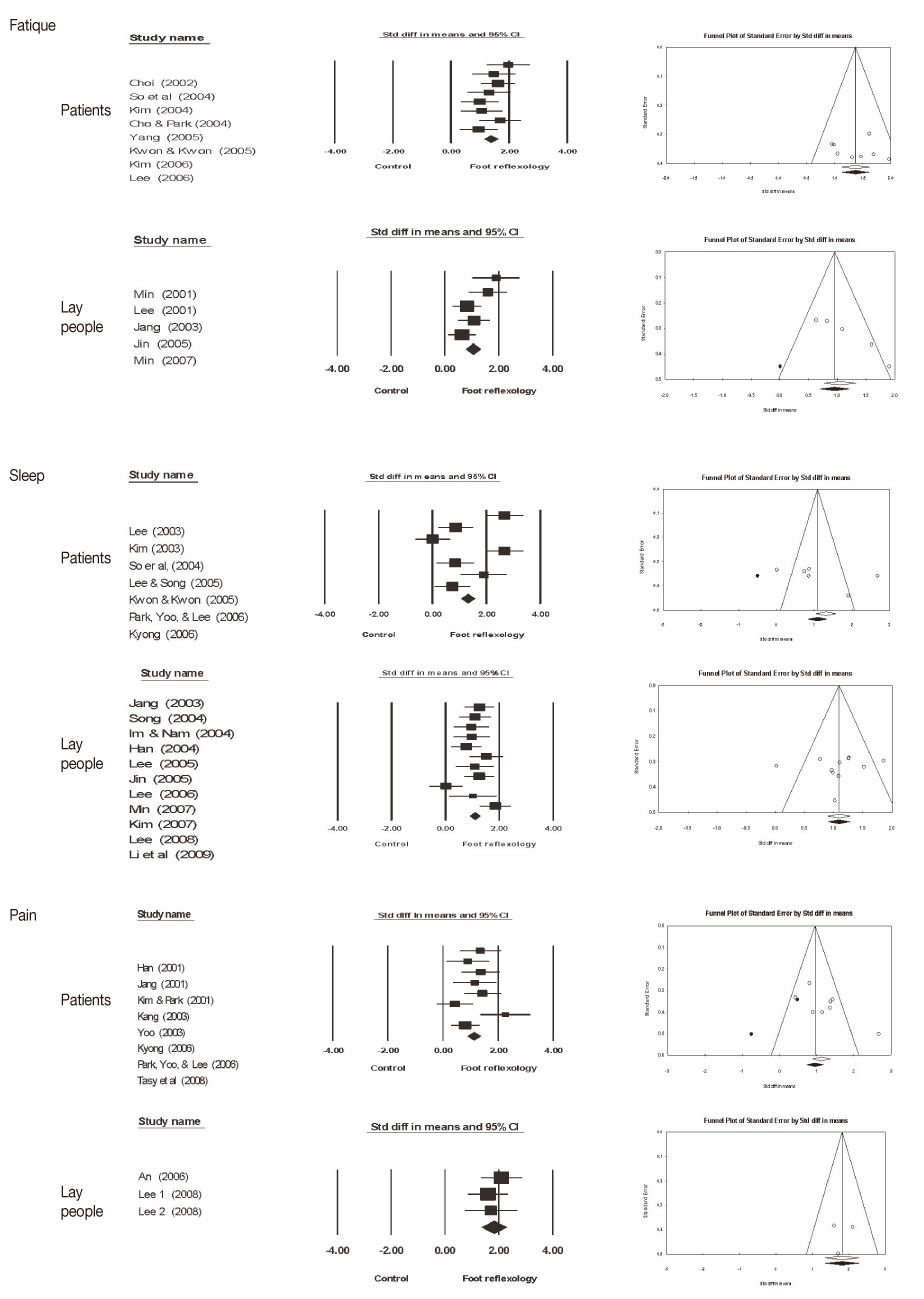
Figure 1
Figure 2
Characteristics of Foot Reflexology Intervention Studies included in Meta-Analysis
Exp.=Experimental group; Cont.=Control group; W=Weeks; D=Days; Weeks=Duration massages were applied; Min=Time per massage; JF=Japanese labor science institute(subjective symptom) of fatigue; VAS=Visual analogue scale; PI=Piper (1987); SH=Synder-Halpern & Verran (1987); Oh=Oh, Song & Kim (1998); Kim=Kim (1984) ; FAI=Fatigue assessment instrument; VDS=Numerical visual descriptor scale; RCT=Randomised controlled trial; WOMAC=Korean version of Western Ontario MacMaster University Oestoarthritis index questionnaire.
Homogeneity, Mean Effect Size and Fail-Safe N of Foot Reflexology
Homo Q (p)=Homogeneity test Q (p), d±SD=Mean ES, Nfs=Fail-safe N
Comparison of Effect Sizes between Patients and Lay People: Fatigue, Sleep & Pain
Exp.=Experimental group; Cont.=Control group; W=Weeks; D=Days; Weeks=Duration massages were applied; Min=Time per massage; JF=Japanese labor science institute(subjective symptom) of fatigue; VAS=Visual analogue scale; PI=Piper (1987); SH=Synder-Halpern & Verran (1987); Oh=Oh, Song & Kim (1998); Kim=Kim (1984) ; FAI=Fatigue assessment instrument; VDS=Numerical visual descriptor scale; RCT=Randomised controlled trial; WOMAC=Korean version of Western Ontario MacMaster University Oestoarthritis index questionnaire.
Homo Q (
 KSNS
KSNS
 E-SUBMISSION
E-SUBMISSION


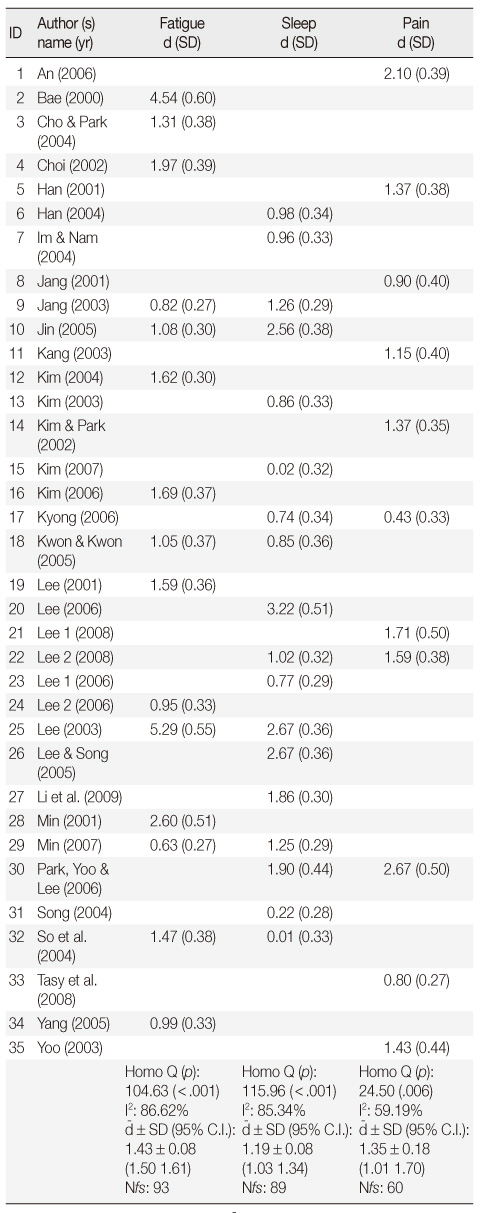
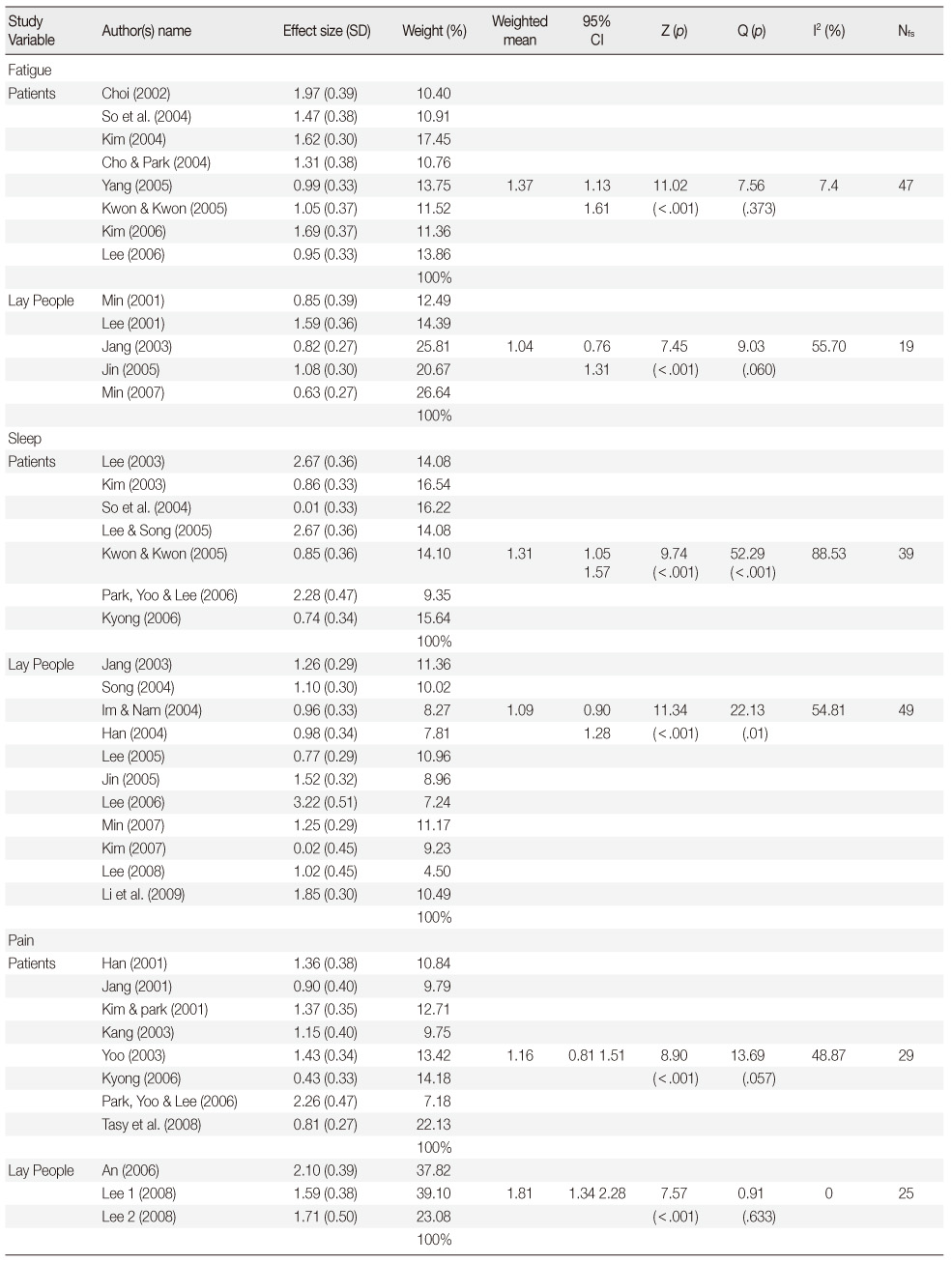
 Cite
Cite

